Saw a great classic (& dusty) car the other day by Mercado 1° de Diciembre….
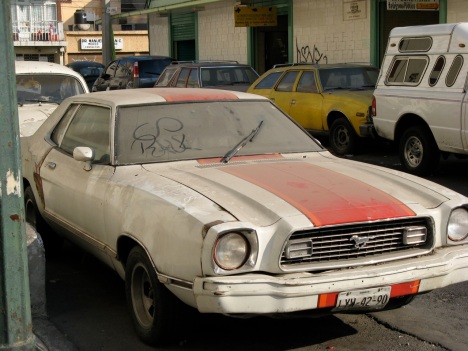
Is this for sale?
México, D.F.
Filed under: Mike's Notes on Mexico: Places and Peoples | Tagged: Cars, Dirty Cars, Mercado 1° de Diciembre, Mexico City | Leave a comment »
Saw a great classic (& dusty) car the other day by Mercado 1° de Diciembre….

Is this for sale?
México, D.F.
Filed under: Mike's Notes on Mexico: Places and Peoples | Tagged: Cars, Dirty Cars, Mercado 1° de Diciembre, Mexico City | Leave a comment »
In the afternoon, along Calle José Martí near my apartment, there are tacos de guisado vendors. Tacos de guisado is a catch-all term to describe a tortilla filled with a variety of prepared meats, vegetables, and moles. For example, one vendor will have big pots full of chiles rellenos, which are enormous chiles stuffed with cheese, washed in egg and either pan-fried or baked; tortitas de pollo o bróculi, thick pancakes with egg and either chicken or broccoli; pork and chicken stewed in a thick and rich mole verde; and sautéed steak with potatoes and peppers; among other dishes. Here, the pork and the chiles are particularly spectacular. A single order is a large tortilla filled with your choice and topped with sauce and a scoopful of rice, which costs 13-15 pesos; 40 pesos will buy an order of three, served with bags of rice, tortillas, and sauce for customers to take and assemble at home.

Chiles rellenos and tortitas... oh, my!
The prepared nature of tacos de guisado means that it is common for vendors to serve from the street, where a portable table or, in this case, the back of a pickup truck serves as the lunch counter. I’ve asked the vendors when they prepare the dishes and the answer is always in the morning before they arrive, usually at their homes and often under the direction of the family matriarch. While some people may flinch at the idea of prepared food being heated and served hours later, to me, it’s nothing different from a potluck or a fancy restaurant; except here it’s being prepared by a grandmother. As long as, once cooked, the dishes are kept away from raw food, then food safety isn’t really that big of an issue… I hope. And for those willing to take the plunge, eating tacos de guisado is, perhaps, the best way to sample a huge variety of mexican dishes in a very authentic environment.
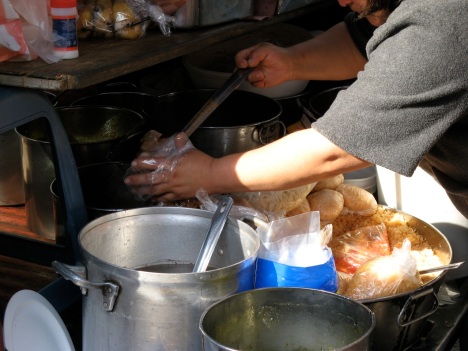
Big pots full of dishes are arranged in the back of a truck
México, D.F.
Filed under: Food – The Outrageously Good, the Bad, and the Tragically Ugly | Tagged: Calle Jose Marti, changarros, chile relleno, chiles rellenos, Escandon, informal markets, mexican cuisine, mexican food, Mexico City, mole verde, street food, tacos, tacos de guisado, tortitas | 1 Comment »
For the inexperienced, finding a taxi in Mexico City can be an unusual, if not daunting, task. Not only are there many ways to catch a taxi, from calling one, to finding a taxi stand, or sitio, to hailing a green bug, or even una pirata, on the street, or even getting a special taxi that serves a hotel or the airport; but rampant stories of express kidnappings and nefarious taxistas feed the imagination and fears of tourists, ex-pats, and locals, alike.
Of course, taxi drivers, companies, and hotels, are keen to these perceptions of safety. Those taxis that are supposed to be safer; those that your agent/guide/friends/etc. tell you to take; those that you call or find at a sitio; are more expensive, often significantly so, and especially at night. Even more expensive are taxis from a hotel, where rates may be double of those from the sitios. For example, a taxi off the street from the airport to my house would likely run about 80 pesos, a taxi from a sitio 120, and the official airport taxi (or one from the Camino Real hotel by the airport) 240 or higher.
Although taking a taxi off the street requires a bit more savvy for the sake of safety, those from sitios and hotels are equally safe and accessible and recommended for the inexperienced; such that the doubling of the rate at the hotel is merely an unofficial “tourist tax.” Nowhere is the fleecing of tourists more apparent than at the airport (at some point, I should break down on this blog all of the surcharges that get added to a ticket when you fly into AICM), where the “official” airport taxis are all astronomically expensive. A few pirate drivers will cruise the airport halls, but I usually avoid them on principle. Instead, with a little initiative and a short walk, it’s possible to find a sitio taxi and halve the cost.
Mexico City Airport Taxi Sitio
As the airport makes a ton of money by having really expensive taxis, the airport sitio (for Terminal 1) is located just off airport property. To find it, cross the skybridge that houses the airport tram; it’s located near Puerto 5. Terminal 1 is linear and the doorways, or puertos, are numbered, in order. Cross the bridge, walking past the tram, and then walk down the stairs to street level — the sitio is the little kiosk on the side of the street at the base of the stairs.
México, D.F.
Filed under: Experiences as a Consumer: La Tramite Más Inutil | Tagged: AICM, airport taxis, Mexico City, Mexico City Airport, Mexico City safety, Mexico City taxis, pirate taxis, safety, sitio taxis, tourist tax | Leave a comment »
One of the things that stood out in my mind while attending a conference at Tec. de Monterrey in Mexico City last week was the campus. The university where I work has relatively little open space or emphasis on architecture, but Tec.’s campus really impressed me with the interesting building designs and the size and openness of the central courtyard. Granted, sometimes the various architectural designs seemed to clash, like the squat building with the round dome, and the purple wall that morphed into the parking structure, but the details of the overall design struck me as being one of utility, openness, and giving rise to contemplation… and isn’t that what a campus is supposed to be?
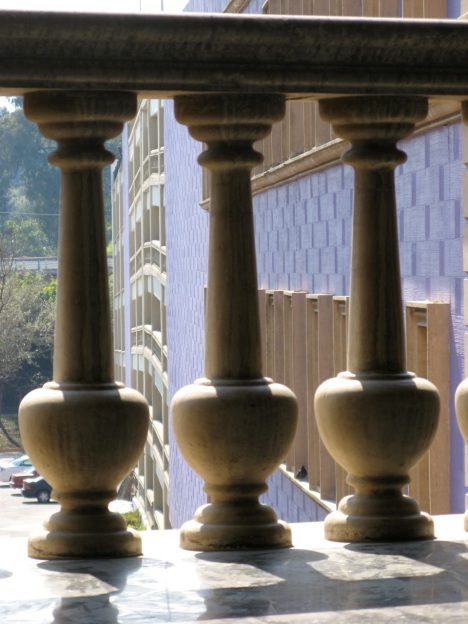
These railing posts imply an almost moorish feel...
México, D.F.
Filed under: Mike's Notes on Mexico: Places and Peoples | Tagged: architecture, Mexico City, Tec de Monterrey, Tecnológico de Monterrey, university campus | Leave a comment »
In our apartment, we use natural gas for both cooking and heating water. However, like much, if not all of Mexico, our gas is delivered in tanks, rather than by pipes under the street. On the roof of our building, we, as well as all of our neighbors, have a tank or two that connects to a small pipe that runs in through our window. And when one tank runs out, we have to go to the roof, switch the line to the spare, and relight the pilots for our appliances. It’s actually not as big of a pain as I would have imagined.
Once a tank is empty, it can be exchanged for a full one by buying it off the street. Three or four times a week, sometimes more, a truck drives through our neighborhood with a load of full tanks. The truck drives very slowly and, as it moves along, an army of workers walk past each apartment building, ringing every doorbell and screaming “gaaaassss!” It took a little getting used to! When your tank is empty, you simply wait for them to ring your bell, and then stick your head out the window and scream back: “gaaaassss!” One of the workers will run to the truck, grab one of these tanks, which must weigh in the neighborhood of 120 pounds-plus, and will carry it up to the roof of your building and connect it. A full, large tank costs 306 pesos (plus the empty spare), and it never hurts to add a small tip to the gas-man.

Replacing the empty tank with a full one...
México, D.F.
Filed under: Experiences as a Consumer: La Tramite Más Inutil, Mike's Notes on Mexico: Places and Peoples | Tagged: customer service, gas, gas tanks, Mexico City, natural gas, street sounds, The Gas-Man | 1 Comment »
On occasion, I take the metrobús home from ITAM and, when I do, I often pass by a park-side shack that sells steak tacos (map). These tacos may be described as steak-and-cheese gifts from heaven, with thin sheetlets of grilled beef, melted queso oaxaqueño, warm corn tortillas, and creative salsas with cucumber, pineapple, radish, and something that might be jicama. And although there are some upscale joints that do mighty-fine steak tacos, too, at 10 pesos apiece, about 70 cents, those here cost less than a fifth of the ones in La Condesa.
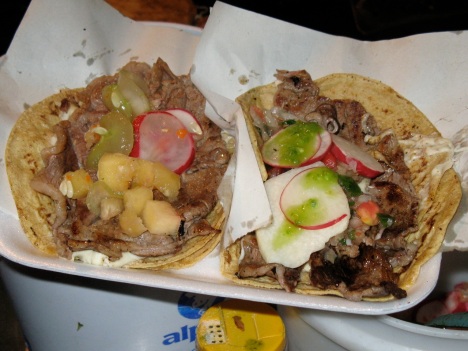
Steak and cheese tacos with salsa
Granted, this little changarro may not be for the faint-of-stomach, as there’s not much in the way of refrigeration or seating (or running water); though, unlike most resorts in Mexico, you can watch the head chef and boss cook up some lovin’ on the grill right in front of you. And the food will taste better here, too.
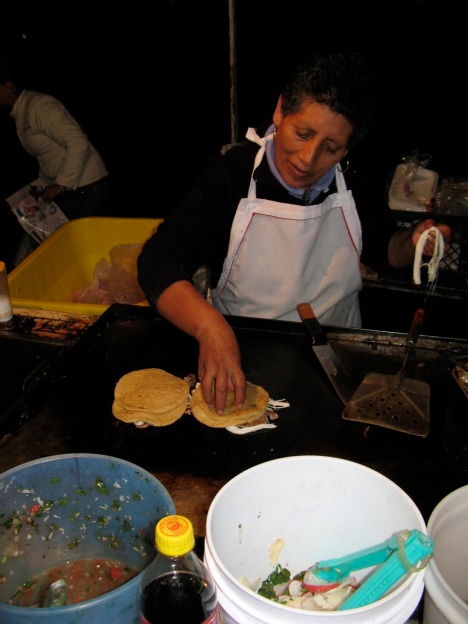
Steak: From the box to the grill to the plate to your mouth
México, D.F.
Filed under: Food – The Outrageously Good, the Bad, and the Tragically Ugly | Tagged: changarros, cheap eats, Mexico City, San Angel, street food, tacos | Leave a comment »
Last Friday night, I went to see the fights at Arena México. Built to house boxing matches for the 1968 Mexico City Olympics, the arena is now used as a venue for “professional” wrestling, or las luchas. My memories of watching wrestling on TV when I was younger helped to prepare me for the experience, with the overstylized drama, elaborate costumes, bizarre plot lines, acrobatic moves, and fake fighting. And, of course, Mexican wrestling is also notorious for “those guys with the funny masks.” (Apologies on the lack of photos! …The arena officials ban cameras.)
But las luchas in Mexico is more than just entertainment, it’s a cultural phenomenon and a window into part of the national psyche. The masks, for example, serve the dual role of both anonymyzing a fighter as well as being exploited by his opponents in order to emasculate him. To really get my head around the experience and figure out what it all means, I’ll probably need to go back… it was, in many senses, overwhelming. Perhaps exceeding the spectacle in the ring is that of watching the fans, groups of which who wore matching costumes, brought bicycle pumps to drive air horns(!), and looked as if they have been attending las luchas as religiously as they do church on Sundays.
Each of the fights we saw featured six luchadores, divided into two teams of three, that would fight in the ring. I had expected the fights to be a bit more structured, with the “official” wrestling only between two luchadores at a time. However, the organization of these fights would quickly deteriorate into a free-for-all, with all six wrestlers performing combo moves in the ring. In one of the early bouts, a very little man accompanied one of the teams out to ringside. I don’t know what the socially accepted term is these days, so I’ll just refer to him as the “little man” or the “wee luchador;” he was about 3′ tall… and dressed in a blue, hairy gorilla suit. I must admit, it was a strange sight….
During the middle of the fight, the wrestlers on the other team grabbed the little guy, pulled him into the ring, and began to “beat” on him. I honestly can’t remember how the crowd reacted, my attention was completely fixated on the post-body-slam motionless body, blue ape suit and all, lying prone in the center of the ring. To heighten the drama of the moment, one of the arena’s medical staff came out, lifted the little man, and carried him out, laid flat in his arms.
Some may say it’s exploitation. But to me it’s no more exploitative than everything else about las luchas, the bikini-clad ladies, stereotypified wrestlers, Mexican-good-ol’-boy announcers, and the fanatics who pay upwards of 300 pesos to watch. In that moment, I could do nothing but stare, gape, and break down into laughter.
México, D.F.
Filed under: Keeping Busy en el D.F., Mike's Notes on Mexico: Places and Peoples | Tagged: Arena Mexico, las luchas, little man, luchadores, Mexican wrestling, Mexico City, professional wrestling | Leave a comment »
Monday and Tuesday of this week, I attended a workshop on cross-border climate policy between Canada, Mexico, and the U.S., at the Tecnológico de Monterrey’s campus in Mexico City (map). The conference was hosted by one of Tec.’s policy research groups, called CEDAN, or el Centro de Diálogo y Análisis sobre América del Norte.
I have a tough time gauging attendance at the workshop, mostly because I don’t know what organizers were planning for. However, those that did attend represented many of the climate change-planning organizations in México, including senior policy-makers from the mayor’s office, the sub-directors of federal institutions such as CTS (Centro de Transport Sustentable), SEMARNAT (Secretaria de Medio Ambiente y Recursos Naturales), and INE (Instituto Nacional de Ecología), directors of NAFTA-sponsored environmental policy groups (COCEF, CEC), and professors from universities in Canada, the U.S., and México. Attendees were very knowledgeable and the presentations were informative. The opening press conference of the event even brought out the mayor de la Ciudad de México, Marcelo Ebrard.
Considering that this event was on climate policy, however, noticeably absent were representatives from Mexico’s industrial sector. As far as I could tell, neither PEMEX nor CEMEX, the oil and cement monopolies, nor any of the other major (electricity, mining, agriculture, tourism) or minor industries sent representatives. More disappointing was that institutions such as SEMARNAT, which are responsible for outlining México’s national climate change strategy, including Mexico’s pledge at Poznan to reduce emissions to half of 2002 levels by 2050, seemed more interested in appearing, rather than participating.
From my perspective, the conference was successful and beneficial for groups that attended and participated, even if only for the point of making contacts. I won’t speculate here about the forces that will come into play to drive México’s climate policy in the next few years, but one would figure that this was a missed opportunity for many of these groups that did not.
México, D.F.
Filed under: * Mexico Climate Change | Tagged: CEC, CEDAN, CEMEX, COCEF, Cross-Border Climate Policy, CTS, INE, Mexican Environmental Policy, Mexico City, NAFTA, PEMEX, SEMARNAT, Tecnológico de Monterrey, US Mexico Relations | 1 Comment »